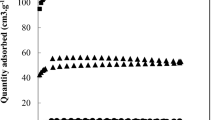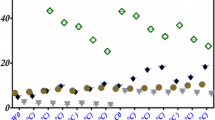Abstract
Purpose
Biochar is increasingly being used as a soil amendment to both increase soil carbon storage and improve soil chemical and biological properties. To better understand the shorter-term (10 months) impacts of biochar on selected soil parameters and biological process in three different textured soils, a wide range of loading rates was applied.
Materials and methods
Biochar derived from eucalypt green waste was mixed at 0, 2.5, 5, 10 % (wt/wt) with a reactive black clay loam (BCL), a non-reactive red loam (RL) and a brown sandy loam (BSL) and placed in pots exposed to the natural elements. After 10 months of incubation, analysis was performed to determine the impacts of the biochar rates on the different soil types. Also, microbial biomass was estimated by the total viable counts (TVC) and DNA extraction. Moreover, potential nitrification rate and community metabolic profiles were assayed to evaluate microbial function and biological process in biochar-amended soils.
Results and discussion
The results showed that biochar additions had a significant impact on NH4 and NO3, total C and N, pH, EC, and soil moisture content in both a soil type and loading-dependent manner. In the heavier and reactive BCL, no significant impact was observed on the available P and K levels, or the total exchangeable base cations (TEB) and CEC. However, in the other lighter soils, biochar addition had a significant effect on the exchangeable Al, Ca, Mg, and Na levels and CEC. There was a relatively limited effect on microbial biomass in amended soils; however, biochar additions and its interactions with different soils reduced the potential nitrification at the higher biochar rate in the two lighter soils. Community metabolic profile results showed that the effect of biochar on carbon substrate utilization was both soil type and loading dependent. The BCL and BSL showed reduced rates of substrate utilization as biochar loading levels increased while the opposite occurred for the RL.
Conclusions
This research shows that biochar can improve soil carbon levels and raise pH but varies with soil type. High biochar loading rates may also influence nitrification and the function and activity of microbial community in lighter soils.











Similar content being viewed by others
References
Alden L, Demoling F, Bååth E (2001) Rapid method of determining factors limiting bacterial growth in soil. Appl Environ Microbiol 67:1830–1838
Atkinson CJ, Fitzgerald JD, Hipps NA (2010) Potential mechanisms for achieving agricultural benefits from biochar application to temperate soils: a review. Plant Soil 337:1–18
Ball PN, MacKenzie MD, DeLuca TH, Montana WEH (2010) Wildfire and charcoal enhance nitrification and ammonium-oxidizing bacterial abundance in dry montane forest soils. J Environ Qual 39:1243
Bamminger C, Zaiser N, Zinsser P, Lamers M, Kammann C, Marhan S (2014) Effects of biochar, earthworms, and litter addition on soil microbial activity and abundance in a temperate agricultural soil. Biol Fert Soils 50:1189–1200
Basso AS, Miguez FE, Laird DA, Horton R, Westgate M (2013) Assessing potential of biochar for increasing water‐holding capacity of sandy soils. GCB Bioenergy 5:132–143
Baudoin E, Benizri E, Guckert A (2003) Impact of artificial root exudates on the bacterial community structure in bulk soil and maize rhizosphere. Soil Biol Biochem 35:1183–1192
Bengtsson G, Bengtson P, Månsson KF (2003) Gross nitrogen mineralization-, immobilization-, and nitrification rates as a function of soil C/N ratio and microbial activity. Soil Biol Biochem 35:143–154
Berglund LM, DeLuca TH, Zackrisson O (2004) Activated carbon amendments to soil alters nitrification rates in Scots pine forests. Soil Biol Biochem 36:2067–2073
Bouzaiane O, Cherif H, Ayari F, Jedidi N, Hassen A (2007) Municipal solid waste compost dose effects on soil microbial biomass determined by chloroform fumigation-extraction and DNA methods. Ann Microbiol 57:681–686
Butnan S, Deenik JL, Toomsan B, Antal MJ, Vityakon P (2015) Biochar characteristics and application rates affecting corn growth and properties of soils contrasting in texture and mineralogy. Geoderma 237:105–116
Chintala R, Mollinedo J, Schumacher TE, Malo DD, Julson JL (2014) Effect of biochar on chemical properties of acidic soil. Arch Agron Soil Sci 60:393–404
Dempster D, Gleeson D, Solaiman Z, Jones D, Murphy D (2012a) Decreased soil microbial biomass and nitrogen mineralisation with Eucalyptus biochar addition to a coarse textured soil. Plant Soil 354:311–324
Dempster DN, Jones DL, Murphy DV (2012b) Clay and biochar amendments decreased inorganic but not dissolved organic nitrogen leaching in soil. Soil Res 50:216–221
Fowles M (2007) Black carbon sequestration as an alternative to bioenergy. Biomass Bioenerg 31:426–432
Frąc M, Oszust K, Lipiec J (2012) Community level physiological profiles (CLPP), characterization and microbial activity of soil amended with dairy sewage sludge. Sensors 12:3253–3268
Garland JL (1997) Analysis and interpretation of community-level physiological profiles in microbial ecology. FEMS Microbiol Ecol 24:289–300
Garland JL, Mills AL (1991) Classification and characterization of heterotrophic microbial communities on the basis of patterns of community-level sole-carbon-source utilization. Appl Environ Microbiol 57:2351–2359
Glaser B, Haumaier L, Guggenberger G, Zech W (2001) The ‘Terra Preta’ phenomenon: a model for sustainable agriculture in the humid tropics. Naturwissenschaften 88:37–41
Gomez E, Garland J, Conti M (2004) Reproducibility in the response of soil bacterial community-level physiological profiles from a land use intensification gradient. Appl Soil Ecol 26:21–30
Gomez J, Denef K, Stewart C, Zheng J, Cotrufo M (2014) Biochar addition rate influences soil microbial abundance and activity in temperate soils. Eur J Soil Sci 65:28–39
Juhnke ME, Mathre D, Sands D (1987) Identification and characterization of rhizosphere-competent bacteria of wheat. Appl Environ Microbiol 53:2793–2799
Kandeler E (1995) Potential nitrification. In: Schinner F, Öhlinger R, Kandeler E, Margesin A (eds) Methods in soil biology. Springer, Berlin, Heidelberg, pp 146–149
Kimetu JM, Lehmann J, Ngoze SO, Mugendi DN, Kinyangi JM, Riha S, Verchot L, Recha JW, Pell AN (2008) Reversibility of soil productivity decline with organic matter of differing quality along a degradation gradient. Ecosystems 11:726–739
Kolb SE, Fermanich KJ, Dornbush ME (2009) Effect of charcoal quantity on microbial biomass and activity in temperate soils. Soil Sci Soc Am J 73:1173–1181
Kookana R, Sarmah A, Van Zwieten L, Krull E, Singh B (2011) Biochar application to soil: agronomic and environmental benefits and unintended consequences. Adv Agron 112:103
Kumar M, Babel A (2011) Available micronutrient status and their relationship with soil properties of Jhunjhunu tehsil, district Jhunjhunu, Rajasthan, India. J Agric Sci 3:97
Lehmann J, Gaunt J, Rondon M (2006) Bio-char sequestration in terrestrial ecosystems—a review. Mitig Adapt Strateg Glob Change 11:395–419
Lehmann J, Rillig MC, Thies J, Masiello CA, Hockaday WC, Crowley D (2011) Biochar effects on soil biota—a review. Soil Biol Biochem 43:1812–1836
Marstorp H, Guan X, Gong P (2000) Relationship between dsDNA, chloroform labile C and ergosterol in soils of different organic matter contents and pH. Soil Biol Biochem 32:879–882
Nelson NO, Agudelo SC, Yuan W, Gan J (2011) Nitrogen and phosphorus availability in biochar-amended soils. Soil Sci 176:218–226
Novak JM, Busscher WJ, Laird DL, Ahmedna M, Watts DW, Niandou MA (2009) Impact of biochar amendment on fertility of a southeastern coastal plain soil. Soil Sci 174:105–112
Noyce GL, Basiliko N, Fulthorpe R, Sackett TE, Thomas SC (2015) Soil microbial responses over 2 years following biochar addition to a north temperate forest. Biol Fert Soils 51:649–659
O’Neill B, Grossman J, Tsai MT, Gomes JE, Lehmann J, Peterson J, Neves E, Thies JE (2009) Bacterial community composition in Brazilian Anthrosols and adjacent soils characterized using culturing and molecular identification. Microb Ecol 58:23–35
Prommer J, Wanek W, Hofhansl F, Trojan D, Offre P, Urich T, Schleper C, Sassmann S, Kitzler B, Soja G (2014) Biochar decelerates soil organic nitrogen cycling but stimulates soil nitrification in a temperate arable field trial. PLoS ONE 9, e86388
Rondon M, Ramirez J, Lehmann J (2005) Greenhouse gas emissions decrease with charcoal additions to tropical soils, Proceedings of the 3rd USDA Symposium on Greenhouse Gases and Carbon Sequestration, Baltimore, USA, 208
Ros M, Klammer S, Knapp B, Aichberger K, Insam H (2006) Long‐term effects of compost amendment of soil on functional and structural diversity and microbial activity. Soil Use Manage 22:209–218
Sohi S, Krull E, Lopez-Capel E, Bol R (2010) A review of biochar and its use and function in soil. Adv Agron 105:47–82
Song Y, Zhang X, Ma B, Chang SX, Gong J (2014) Biochar addition affected the dynamics of ammonia oxidizers and nitrification in microcosms of a coastal alkaline soil. Biol Fert Soils 50:321–332
Steiner C, Teixeira WG, Lehmann J, Nehls T, de Macêdo JLV, Blum WE, Zech W (2007) Long term effects of manure, charcoal and mineral fertilization on crop production and fertility on a highly weathered Central Amazonian upland soil. Plant Soil 291:275–290
Ulyett J, Sakrabani R, Kibblewhite M, Hann M (2014) Impact of biochar addition on water retention, nitrification and carbon dioxide evolution from two sandy loam soils. Eur J Soil Sci 65:96–104
Unger R, Killorn R, Brewer C (2011) Effects of soil application of different biochars on selected soil chemical properties. Commun Soil Sci Plant Anal 42:2310–2321
Uzoma K, Inoue M, Andry H, Fujimaki H, Zahoor A, Nishihara E (2011) Effect of cow manure biochar on maize productivity under sandy soil condition. Soil Use Manager 27:205–212
Weber KP, Legge RL (2009) One-dimensional metric for tracking bacterial community divergence using sole carbon source utilization patterns. J Microbiol Methods 79:55–61
Yao Y, Gao B, Zhang M, Inyang M, Zimmerman AR (2012) Effect of biochar amendment on sorption and leaching of nitrate, ammonium, and phosphate in a sandy soil. Chemosphere 89:1467–1471
Yoshitake S, Uchida M, Koizumi H, Nakatsubo T (2007) Carbon and nitrogen limitation of soil microbial respiration in a High Arctic successional glacier foreland near Ny‐Ålesund, Svalbard. Polar Res 26:22–30
Zhang H, Voroney R, Price G (2015) Effects of temperature and processing conditions on biochar chemical properties and their influence on soil C and N transformations. Soil Biol Biochem 83:19–28
Zimmerman AR (2010) Abiotic and microbial oxidation of laboratory-produced black carbon (biochar). Environ Sci Technol 44:1295–1301
Acknowledgements
We would like to express our appreciation to all colleagues who provided help during the sample collection. Also, we gratefully thank Mr. Stephen Paterson for technical assistance.
Author information
Authors and Affiliations
Corresponding author
Additional information
Responsible editor: Hailong Wang
Rights and permissions
About this article
Cite this article
Abujabhah, I.S., Doyle, R., Bound, S.A. et al. The effect of biochar loading rates on soil fertility, soil biomass, potential nitrification, and soil community metabolic profiles in three different soils. J Soils Sediments 16, 2211–2222 (2016). https://doi.org/10.1007/s11368-016-1411-8
Received:
Accepted:
Published:
Issue Date:
DOI: https://doi.org/10.1007/s11368-016-1411-8




